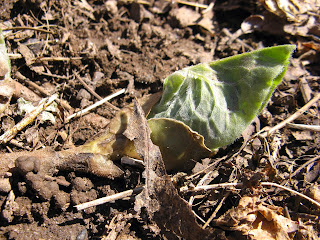Thunder
rumbled in the distance, but just a few sprinkles decorated the windshield as
we rolled slowly down the gravel road. With eyes trained on the roadside
vegetation, we searched for clues that our quarry was near. Too dry. Too
grassy. Too brushy. Too wet. Then, finally: moist soil; a clearing in the
trees; and tall brown stalks marked the spot.
Grabbing
plastic bags and rain jackets, we clambered out of the car for a closer look.
Curled up at the base of a brown stalk was a cluster of tiny curlicues. Each
green stem was rolled up like the elegant scrollwork at the top of a violin.
Delicate, fawn-brown flakes clung to the curlicues, like tissue paper
protecting something precious.
Fiddlehead
ferns! Their unique pattern of emergence, called circinate vernation, protects
the tender growing tip of the frond within the tightly curled bundle of leaves.
The lower parts of the leaf expand and toughen up first, until finally the tip
of the frond unfolds—hopefully after the danger of hard frost is past. Not only
is this method of growth practical, it is lovely to observe.
I
had been worried that we’d waited too long (spring is so busy!), and had missed
the brief, edible stage of the Ostrich Fern. Indeed, several clusters within
the patch had already unfurled their fronds completely, rendering them inedible
for humans. Snapping off one or two of the tightly curled fiddleheads from each
bunch, we worked to fill our bag. A swarm of blackflies encouraged us to move
quickly.
This
wild vegetable is a spring delicacy among many people in the Northeast and
Upper Midwest. With a pleasant flavor I describe as “green,” and a beautiful shape,
fiddleheads can be cooked into many tasty dishes. It is important to identify
your fiddleheads correctly, though, since many other ferns can cause stomach
upset, and are known to contain carcinogens. Plus, they often taste terribly
bitter. Ostrich Ferns, the most easily prepared edible fern around here, have a
smooth stem with no hairs, light brown, papery flakes called scales that
protect the emerging frond, and a deep groove on the front of the stalk. If the
fiddleheads you see are covered in light orange fuzz or black hairs, leave them
be.
Once
you’ve identified your fiddleheads correctly, it is also important to boil them
before you eat them. There have been several cases of an unidentified foodborne
illness after eating raw or lightly cooked fiddleheads. Steaming or boiling for
10-15 minutes seems to eliminate that risk. I like to clean and boil my bagful
all at once, and then throw the cooked vegetables into a skillet with butter
and garlic, or into my morning omelet. A fiddlehead tempura recipe I recently
saw online looks tempting, too.
Why
should you bother to brave blackflies and wet feet to collect this odd meal?
Fiddleheads are high in vitamins A and C, contain a variety of minerals, and
like most vegetables are high in fiber and low in calories. Canadian
researchers have recently discovered that they contain significant amounts of
omega-3 fatty acids, and twice the antioxidants of blueberries. Plus, I love to
feel connected to my local ecosystem by becoming part of its food chain and
energy flow (in addition to my annual donation to the mosquito food bank.)
Foraging
also gives me an excuse to explore. Ostrich Ferns form great colonies in river
bottoms, and in rich, moist, forest soils across northern North America,
eastern and northern Europe, and northern Asia. Their name comes from their
huge, elegant, plume-shaped leaves. They can grow from the spores released from
the odd-looking brown frond that sticks up from each clump all winter, and
marks the patches each spring. Or they can spread through underground stems
called rhizomes. The intricate network of rhizomes in a dense patch of ferns
can help reduce soil erosion.
For
many reasons, it is important to harvest fiddleheads—or any wild
edible—responsibly. The University of Maine did research on the effect of several
harvest methods. They found that harvesting no more than half of the
fiddleheads within a single crown does not reduce the vigor of the plant. I
usually stick to just one or two fiddleheads from each crown, and skip the
smallest clumps altogether.
As
our bag filled, the rumble of thunder faded into the distance and was replaced
by a cheery blue sky. When a slight breeze blew away the black flies, we were
able to unfurl ourselves, throw off our protective coverings, and enjoy the
emergence of spring.
For over 45 years, the Cable Natural
History Museum has served to connect you to the Northwoods. Come visit us in
Cable, WI! Our new exhibit: “Lake Alive!” opened May 1, 2015, and will remain
open until March 2016.
Find us on the web at
www.cablemuseum.org to learn more about our exhibits and programs. Discover us
on Facebook, or at our blogspot,
http://cablemuseumnaturalconnections.blogspot.com.



